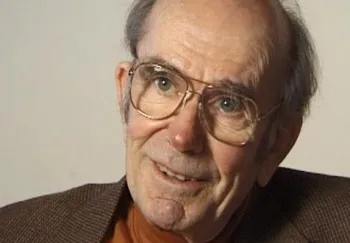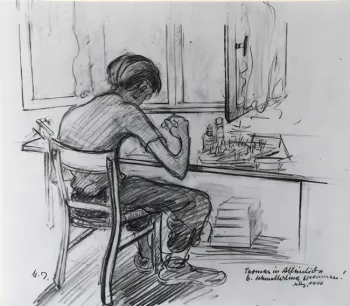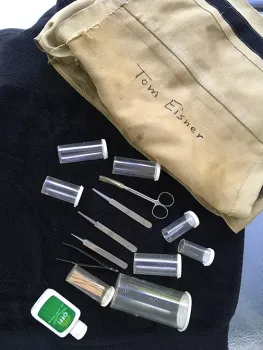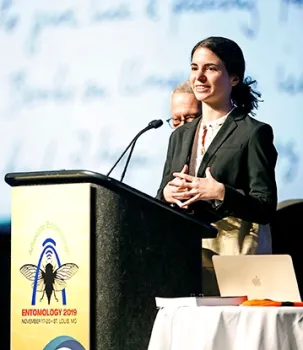
When UC Davis distinguished professor Walter Leal delivered the Founders' Memorial Lecture at the recent Entomological Society of America (ESA) meeting in St. Louis, Mo., he repeatedly asked that question as he honored the legendary Tom Eisner (1929-2011), known as “the father of chemical ecology” and “the world's best scientist.”
Speaking on “Tom Eisner: an Incorrigible Entomophile and Innovator Par Excellence,” Leal, a distinguished professor in the UC Davis Department of Molecular and Cellular Biology and former chair of the UC Davis Department of Entomology, chronicled Eisner's rejections, acceptances and accomplishments. His lecture drew smiles, laughter and tears and a live tweet from former ESA president May Berenbaum: “Brilliant Founders' Memorial Lecture by Walter Leal honoring the legendary Tom Eisner! Informative, inspiring, insightful – incredible!”
Leal, a chemical ecologist whose own exemplary career spans three decades and includes major discoveries and national and international honors, said he built his career on Eisner's work.
Tom, born to chemist Hans Eisner and artist Margarete Heil-Eisner, fled Nazi Germany in April 1933 with his family and lived in Spain and Uruguay before settling in the United States in 1947. Insects always fascinated him. At age 11, Tom's mother sketched him pinning insects, an inkling of what was to come. On his 12th birthday, his parents gave him a book on butterflies, his first insect book. He would become a world-renowned field biologist whose discoveries repeatedly landed on the covers of Science. He would receive the National Medical of Science (1994). His research on the defensive bombardier beetle spray and his nine books, including For Love of Insects and Secret Weapons: Defenses of Insects, Spiders, Scorpions and Many Other Legged Creatures, would drew international acclaim.
At age 17, Tom emerged as a budding scientist, accomplished pianist, and multilingual in German, French, Spanish, and English. He worked with bee biologist Charles Michener of the American Museum of Natural History, who encouraged him to study entomology. But when Tom applied to Cornell University, hoping to begin his undergraduate studies, he received a crushing rejection letter.

Leal showcased the letter on his PowerPoint presentation, paused for effect, and then quipped “OK, boomer!” as the audience roared.
Leal compared the rejection to what basketball legend Michael Jordan experienced in failing to gain a spot on his high school team. “Michael Jordan was the Tom Eisner of NBA,” Leal told the crowd.
Determined to succeed, Tom went on to attend community college, and obtain his bachelor's degree (1951) and his doctorate (1955) in biology from Harvard. In 1952, he married Maria Lo¨bell, an accomplished scientist and pianist (they played duets on their Steinway pianos). They were wed 58 years. The marriage produced three daughters.
Ironically, 10 years after Cornell officials sent him the “Dear Tom” letter, they hired him as an assistant professor. He advanced to associate professor in 1962, full professor in 1966, and then the Jacob Gould Schurman Professor of Chemical Ecology in 1976. He retired in 2006 but worked many years past retirement. All the while, Eisner kept Cornell's rejection letter prominently displayed on his office wall.

Eisner was not only a renowned scientist and an accomplished classical pianist but a masterful photographer and videographer known for capturing the images of the explosive defensive discharge of the bombardier beetle.
Eisner and his close friend and collaborator Cornell chemical professor Jerry Meinwald (1927-2018), made music and science discoveries together. Photos show Eisner playing the piano, and Meinwald, the flute. And together, Leal related, “The Tom and Jerry of the Scientific World” co-authored more than 150 papers.
Laughter erupted when Leal pointed out that for many academicians, the student online commentary, “Rate My Professor” often turns out to be “Hate My Professor.”
But not for Tom Eisner. Typical of the unsolicited student comments: “This guy is a living legend. He has over 500 published papers, and has been the pioneer for the field of chemical ecology His story-telling is fantastic, and all of the stuff he talks about is just so interesting. One of my favorite professors that I have ever had, I stand in awe of his accomplishment as a researcher and a teacher.”
Where is Tom's entomology kit? Does anybody know?
Leal said that Eisner carried his burlap kit in the field for decades, performing insect research on four continents and producing important discoveries. It contained collecting jars, tweezers, toothpicks, dissecting tools and entomology books. Using the kit, he dissected insects, milked venom, and analyzed the results.
With suspense building, Leal finally revealed the whereabouts of the kit.
Who inherited the kit? A 14-year-old bug enthusiast named Katherine Angier, daughter of celebrated New York Times writer Natalie Angier. Eisner also gifted her with his first insect book.
Eisner, who met Katherine at age 5, marveled at her childhood fascination with insects, similar to his perpetual childlike wonder of insects. They kept in touch for a decade.
“She has now graduated from Princeton summa cum laude in biology,” Leal told the crowd, “and she's here in the audience.”
Tears flowed as Angier walked on stage shouldering Eisner's familiar burlap bag, lettered simply with “Tom Eisner.”

The renowned scientist and the inquisitive kindergartner connected. “We went to his house in Ithaca and we just wandered around a field looking for bugs together. And even my kindergartner brain knew it was something I would never forget.”
So for the next decade, young Katherine would write him letters “describing cool bugs that I would see and their behaviors and he was always so encouraging with his replies. He even sent me a dissecting scope that I could use to examine them.”
“Eventually I couldn't read his replies because his Parkinson's disease--it was getting worse. And when I was 14, he did send me this kit, which at first I was really happy about because it had all these really cool things in it, but then when he died (at age 81) shortly thereafter, I realized it was kind of a goodbye kit.”
During her senior year in college, “I started this senior thesis research on an ant plant mutualism in Panama and I decided it was time (to use the kit),” Angier said. “I felt like I was finally going to join the world of entomologists so I brought it with me and I thought it was kind of a good-luck charm.”
“So thank you, Tom, for being there with me and I just want to say that I hope he'd be proud that I (evolved) from a kid hardly able to pronounce the word entomology to now applying for a PhD.”
The thundering applause drowned out the rest of the comments.
The seminar culminated with Leal donating his $1000 honorarium to the ESA Chrysalis Fund, which supports and enhances insect education for kindergarten-12th grade students.
Accolades
Accolades on the memorable lecture continue to stream in.
Cornell alumnus May Berenbaum, professor and chair of the Department of Entomology at the University of Illinois, and a close friend of Eisner's, recommends that all entomology students watch Leal's seminar. (See her biography on Eisner).
Doctoral candidate and ant specialist Brendon Boudinot of the UC Davis Department of Entomology agrees. “Honestly, I didn't know what to expect for Walter's talk. It was a really personal and emphatic portrait of Thomas Eisner. I've known Eisner's work even before I knew I was going to be an entomologist—in fact, upon reading his book For Love of Insects, I knew that entomology was a direction I should go. Walter's talk walked the audience through Eisner's early life and included numerous video clips of researchers relating their experiences and thoughts about him. The whole talk was engaging, but it is true: We, the audience, were in physical tears for the sadness of his loss. Because there is a recording, I can only recommend watching that. Again, I didn't know what to expect, but I was very glad I came. It was one of the most remarkable talks I have ever been to.”
Noted chemical ecologist Wendell Roelofs of Cornell University, who watched the seminar on YouTube, described the lecture as “so fantastic and compelling that I could not turn it off.”

Christina Grozinger, distinguished professor of entomology and director of the Center for Pollinator Research at Pennsylvania State University, commented: “This was a truly amazing and inspiring lecture, which gave a wonderfully holistic view of how Eisner's personal and professional experiences, love of insects, and intense curiosity lead to such remarkable achievements. The videos from diverse entomologists sharing their personal memories of Eisner eloquently captured his profound influence on the community and the field of chemical ecology."
Chemical ecologist Anne Jones of Pennsylvania State University said she particularly “enjoyed all the video clips of so many other important chemical ecologists (some of whom I've had the honor to meet) sharing their memories and stories about Dr. Eisner. It was very special to hear from and meet Katherine Angier as well.”
Jones added: “I grew up hearing about his and Jerry Meinwald's collaborations and discoveries (my dad is Tappey Jones) and read Dr. Eisner's book, For Love of Insects, when it was published…I know that my career path has very much been shaped by the research and inspiration by all of you who were so integral as pioneers in that field.”
One of the videos depicts an interview with honey bee geneticist Robert Page Jr., UC Davis distinguished emeritus professor of entomology and Arizona State University emeritus university provost.
Page recalled that as a graduate student at UC Davis, he remembered reading Eisner's papers in Science. “I was always waiting for the next great exciting discovery he would do with all the intricate clever stories.”
Resources:
- Walter Leal's Founder's Memorial Lecture on YouTube
- Paths of Discovery, Lighted by a Bug Man's Insights, by Natalie Angier, New York Times
- May Berenbaum's Biography of Tom Eisner

